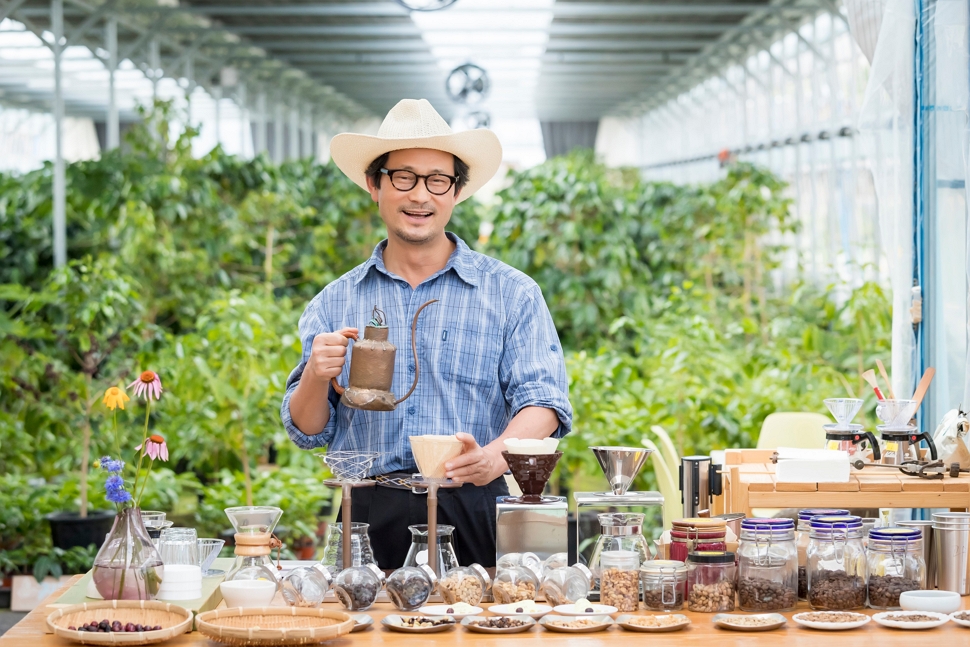Bucking naysayers, Korean farmer grows coffee beans in greenhouse
Date May 06, 2021
 Photojournalist-turned-farmer Lim Young-ju. Courtesy of Lim Young-ju
Photojournalist-turned-farmer Lim Young-ju. Courtesy of Lim Young-ju
●Korea used to import all of its coffee. It is growing coffee beans now, albeit with a modest start.
●The homegrown coffee is fresh with an earthy, smooth and acidic taste that leaves a sweet and fruity aftertaste.
●Farmers are optimistic about mass coffee production in the future since non-indigenous green tea trees adapted well to the climate of Korea’s southwest.
DAMYANG, South Korea -- Lim Young-ju, a photojournalist-turned-farmer, carefully checks the cherries on coffee trees he planted inside greenhouses set up on his farm eight years ago in Damyang-gun, a county in Jeollanam-do Province that is famous for scenic bamboo forests. Some of the coffee cherries have turned red while others are still green.
Two thousand healthy coffee trees are growing there – from saplings as young as a month-old to mature ones. They are his pride and joy as a coffee farmer. His small farm is living proof that defies the popular belief that Korea is unfit for coffee bean farming.
He sips homegrown coffee every morning freshly brewed from beans grown on his farm.
“Korean coffee is fresher than imported varieties,” he said when asked about the difference. “Homegrown coffee may not be as great as imported coffee in terms of taste and flavor, but ours is fresh. There’s no question about that. It usually takes months to import coffee from other countries as they are shipped here and clearing customs also takes time.”
Lim named his coffee “Gold Castle” after the literal translation of Geumsung-myeon, the township where he lives surrounded by mountains.
The coffee farmer compared his homegrown coffee to rice as a point of reference.
“Let’s suppose there are two types of rice – one is premium quality but aged and the other is newly-harvested but of inferior quality. Which one would you choose? It’s a matter of choice, and consumers have different preferences,” he said.
Unlike many global coffee brands, Gold Castle is fermented coffee based on Lim’s own recipe. “The fresh brewed coffee has a complex taste. It’s acidic, but smooth. It’s spicy and has a sweet and fruity aftertaste. Some of our customers say they feel like they’re sipping wine,” he said. “They’re right. Gold Castle has that taste, too.”
Gold Castle’s annual production falls far short of typical small farm harvests in other coffee-growing countries, mainly because Korea’s relatively harsh winter weather drives coffee farmers to spend a lot to install greenhouses and necessary heating and de-humidifying equipment.
The mercury falls below zero during winter in Korea, requiring farmers to spend money to protect coffee trees from the extreme weather. Coffee grows well in cool to warm tropical climates.
Although production is limited, Lim said his farm produces enough coffee every year to serve his clients.
To be self-sufficient, Lim is diversifying his agribusiness.
He operates a coffee-tasting café where tourists can brew and enjoy their own coffee with his beans. Before the pandemic, up to 10,000 people visited his coffee farm annually.
Only his loyal customers can buy his whole beans or ground coffee. He says they are coffee aficionados.
Lim is the only coffee farmer in Damyang-gun. But coffee trees are also growing in other parts of Jeollanam-do, including Goheung-gun and the city of Suncheon.
Like Lim, farmers in those regions grow coffee trees in greenhouses, and their annual production is limited. They also run coffee shops, sell small coffee trees and earn additional income from coffee-tasting facilities they set up near their farms.
Korean farmers producing coffee was unthinkable just a decade ago.
Though no longer entirely dependent on imports, Korea still imports the soft commodity from other countries. Coffee imports have increased sharply since 2013 as consumption has grown fast and coffee retail businesses here have been thriving. In 2019, Korea imported 150,000 tons of coffee. The figure increased more than 5 percent the following year.
Cold winters make Korea inhospitable to coffee production. Innovative farmers, however, challenged that conventional thinking and started experimenting.
Asked when Korea would be able to produce enough coffee to meet local demand, Lim said the local coffee industry is in its infancy and mass production may remain a distant goal, at least in the foreseeable future. But he remains optimistic about homegrown coffee’s prospects.
“Like coffee, green tea trees are not indigenous. They require climatic conditions similar to coffee. What happened with green tea gives us hope for coffee,” he said. “Since they were introduced in Korea over a thousand years ago, green tea trees have grown well in the relatively warm southern part of this country. Some day we may see coffee trees growing on farms, outside greenhouses, after the trees successfully adapt to the local climate.”

The Ministry of Culture, Sports and Tourism's "Korea Here & Now" work can be used under the condition of "Public Nuri Type 1 (Source Indication)."




